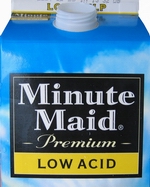Acid Erosion
The tops of these teeth look like melting popsicles.
It's not decay - the enamel has been
dissolved away - by acid.
This kind of tooth damage used to be common mainly in people with eating disorders. But the number of patients with significant damage to their tooth enamel is skyrocketting these days. We're seeing all kinds of people with the enamel on the tops or sides of their teeth perforated or completely dissolved away. The damage can be severe, creating severe wear, and tooth sensitivity that can ultimately require extensive treatment - and thousands of dollars - to repair.
Among the chief culprits: diet pop and orange juice.
Diet pop? Orange Juice? That's right. These and similar drinks can do tremendous harm to your teeth. And it's not the sugar - it's the acid.
Did you ever notice your teeth feeling slightly rough when you rub them together after having a coke? The enamel has been slightly etched - making it rough - by the phosphoric acid that is one of the ingredients. Carbonation itself adds acidity as well as fizz, because the carbon dioxide creates carbonic acid in solution. Natural products like lemons and orange juice is also acidic because of the citric and ascorbic acid they contain. (Even vitamin C can hurt your teeth with prolongued exposure - this is the reason we suggest swallowing without sucking on the tablets.)
A wide variety of snack drinks and food - including many natural juices - have surprisingly low pH (in other words, they're acidic). Tooth enamel is mostly calcium, and acid will dissolve it the same way descaler solution dissolves the scale in the bottom of your kettle. And it takes surprisingly little acidity - anything with a pH below 5 can do it. Teenagers are the most frequent victims of acid damage because they drink a lot of pop and juices, and tend to sip and swish it in their mouths. And here's a statistic for you: North American women drink more Diet Coke than water!
|
|
|
|
|
|
|
|
|
|
|
|
|
|
|
|
|
|
|
|
|
|
|
|
|
|
|
|
|
|
|
|
|
|
|
|
|
|
|
|
|
|
|
|
|
|
|
|
The table below shows typical pH (acidity) for some common foods and beverages. (Battery acid is there, not as a beverage, but for comparison.)
Don't let us scare you away from everything on the list. There are three critical factors that determine the amount of harm dietary acidity can do to your teeth:
Acidity.
The lower-pH drinks, like Pop and lemonade, are the worst offenders
Frequency. Anyone can have a Coke once in a while without harm - its what you drink habitually that matters.
Exposure time. Sipping acidic drinks slowly (or, even worse, swishing it about in your mouth before swallowing) gives it more time to attack your tooth enamel To minimize the effect, drink it quickly and try to keep it off your teeth!

Caveat Emptor
There always
seems to be someone ready to market any new health trend - just look at
all the foods conspicuously labelled "Cholesterol Free".
When we
first saw this juice label, we hoped it would really be a
better
product. But nowhere on the box did it specify exactly how much "lower
in acid" it was. We wrote the company asking for details and ..... they
didn't answer. If we ever do get the figures, we'll post it, but in the
mean time it looks like just marketing hype.